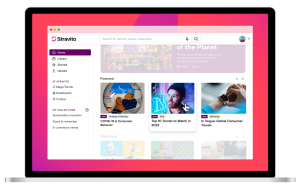Healthy Big Data: Devices Plus Information Make Us Fit
![]() Technology, often considered detrimental to our health, is changing its tune for our benefit. In today’s health and fitness big data write-up we look at the latest ways in which devices team up with data to help people become healthier beings.
Technology, often considered detrimental to our health, is changing its tune for our benefit. In today’s health and fitness big data write-up we look at the latest ways in which devices team up with data to help people become healthier beings.
A watch that watches you
The amount of activity you do in a day may seem impossible to track, but with the new Nike+FuelBand and Fit Link armband, you’ll be able to do just that. A comfortable plastic wristband, Fuelband will measure the wearer’s every step, calories burned and fuel levels, then sync it with an iPhone app. It also boasts an LED display with a battery that will last up to 4 days. It acts as a watch too, and comes in three sizes.
The Link armband does pretty much the same thing but detects the skin’s surface temperature as well. It also measures the body’s reaction to changes in heart rate.
Mobile ECG
![]() Next, we have mobile electrocardiograms (ECG) maker AliveCor announcing that its device successfully and intuitively monitored users’ heart rates as they held the device in their hands or against their chest. It’s the size of a credit card, designed to help physicians and health care providers monitor and gauge a person’s heart health. The idea behind the mobile ECG lies in the way electrodes are incorporated into a wireless case that snaps onto the back of a smartphone. It provides a wireless single-lead recording of rhythm strips for 30 seconds. The data gathered is stored in the device and the cloud.
Next, we have mobile electrocardiograms (ECG) maker AliveCor announcing that its device successfully and intuitively monitored users’ heart rates as they held the device in their hands or against their chest. It’s the size of a credit card, designed to help physicians and health care providers monitor and gauge a person’s heart health. The idea behind the mobile ECG lies in the way electrodes are incorporated into a wireless case that snaps onto the back of a smartphone. It provides a wireless single-lead recording of rhythm strips for 30 seconds. The data gathered is stored in the device and the cloud.
See the entire Healthy Big Data Series on Pinterest and Springpad!
.
A new look inside
![]() Meanwhile, researchers at Yale developed an innovative magnetic resonance imaging (MRI) technology to create 3D images of the hard and soft solids inside the body based on signals emitted by their phosphorous content. Regular MRIs only produce an image by controlling an object’s hydrogen atoms with magnets and radio waves.
Meanwhile, researchers at Yale developed an innovative magnetic resonance imaging (MRI) technology to create 3D images of the hard and soft solids inside the body based on signals emitted by their phosphorous content. Regular MRIs only produce an image by controlling an object’s hydrogen atoms with magnets and radio waves.
“This study represents a critical advance because it describes a way to ‘see’ phosphorus in bone with sufficient resolution to compliment what we can determine about bone structure using x-rays,” says Karl L. Insogna, a professor at Yale School of Medicine and director of the Yale Bone Center. “It opens up an entirely new approach to assessing bone quality.”
Smart phone to stop smoking
Smoking is one of the biggest problems in the world today. Some are so addicted to nicotine that they can’t stop. The Penn State team decided to take action using a decade-old statistical model that can gather information from smartphones, hand-held computers and other mobile devices and give researchers a closer look at how nicotine dependence and negative emotional control states urge people to smoke. It also allows researchers to look at more than one variable at a time.
“To me, the biggest innovation here is looking at how something like baseline dependence is predictive of that behavior over time or the urge to smoke over time,” says Stephanie Lanza, scientific director of The Methodology Center at Penn State “It’s now expressed as a function of time. Instead of saying ‘if you’re higher on dependence you’re going to have a higher urge to smoke over time,’ you can now depict how that association between baseline dependence and urge to smoke varies with time in a very fluid and naturalistic way.”
A message from John Furrier, co-founder of SiliconANGLE:
Your vote of support is important to us and it helps us keep the content FREE.
One click below supports our mission to provide free, deep, and relevant content.
Join our community on YouTube
Join the community that includes more than 15,000 #CubeAlumni experts, including Amazon.com CEO Andy Jassy, Dell Technologies founder and CEO Michael Dell, Intel CEO Pat Gelsinger, and many more luminaries and experts.
THANK YOU













